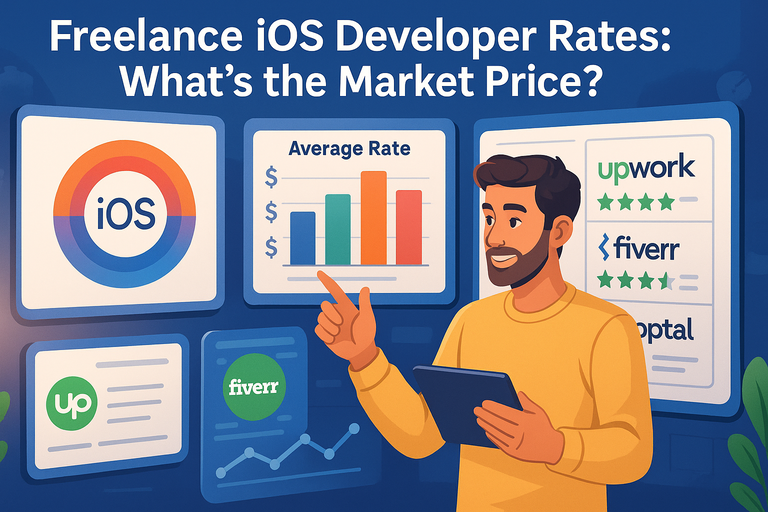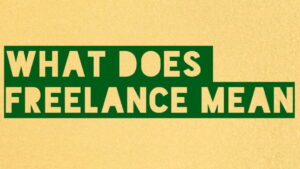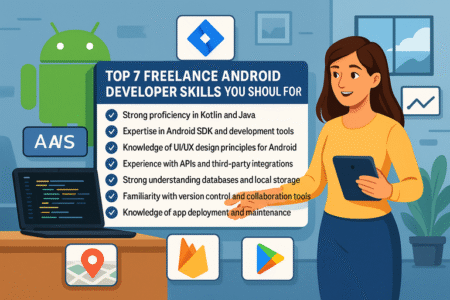Table of Contents
Freelance iOS developer rates can feel like a mystery box—sometimes surprisingly high, other times shockingly low. If you’re a company hiring or a developer setting your price, you’ve probably wondered: What’s the real market price for iOS development work today?
The truth is, rates vary widely depending on skill level, project scope, and even where in the world the developer lives.
In this guide, we’ll unpack what shapes freelance iOS developer pricing and help you get a clear sense of what’s fair in today’s market.
Average Freelance iOS Developer Rates in 2025
If you’ve ever tried to hire a freelance iOS developer, you’ve probably noticed the price range is all over the place.
One person might quote $25 an hour, while another asks for $150+. Both might be perfectly valid depending on who they are, where they live, and what your project needs.
Let’s break down the actual averages in 2025 so you can walk away with a clear benchmark.
Hourly Rates Across Different Regions
Rates depend heavily on geography. A developer living in San Francisco or London is almost always going to charge more than someone in Eastern Europe or South Asia, simply because the cost of living (and the local market demand) is higher.
- United States & Canada: $80–$150 per hour is the common range for experienced iOS developers. Silicon Valley freelancers can even push $200+.
- Western Europe (UK, Germany, France): $60–$120 per hour, with London-based developers typically at the upper end.
- Eastern Europe (Poland, Ukraine, Romania): $30–$70 per hour. Many skilled developers here compete on affordability while still delivering high-quality code.
- India & Southeast Asia: $20–$50 per hour. Lower rates don’t always mean lower skill, but you may need to account for timezone coordination and communication differences.
From what I’ve seen, companies often mix these rates strategically—hiring a high-cost developer for architecture and key decisions, then supplementing with lower-cost freelancers for routine coding.
Typical Monthly Earnings for Full-Time Freelancers
Let’s do some quick math. If a freelancer bills 30 hours a week at their average rate, here’s what their monthly earnings might look like:
- US/Canada: $9,600–$18,000 per month
- Western Europe: $7,200–$14,400 per month
- Eastern Europe: $3,600–$8,400 per month
- India/SE Asia: $2,400–$6,000 per month
Of course, this assumes steady work—which isn’t always guaranteed. Many freelancers will plan for downtime by charging higher rates or keeping multiple clients at once.
Pro tip: Freelancers rarely work 40 billable hours every week. There’s unpaid time spent on admin, proposals, and client calls. A “full-time” freelance workload often means 25–35 billable hours weekly.
How Experience Levels Affect Average Rates
Experience is one of the strongest pricing levers. Here’s how it typically plays out:
- Entry-Level (0–2 years): $20–$40/hour. These developers can handle simpler projects like bug fixes or basic UI but may need guidance.
- Mid-Level (3–5 years): $40–$80/hour. At this stage, most can manage an app from scratch, work independently, and deliver reliable results.
- Senior (6+ years): $80–$150/hour. These developers bring deep expertise, often in niche areas like ARKit, SwiftUI animations, or payment integrations.
I suggest thinking about value rather than cost. A senior who finishes in 20 hours what a junior would take 60 hours to complete is often the better investment.
Comparing Junior, Mid-Level, and Senior Developers
When clients ask me how to decide between levels, I usually frame it like this:
- Junior developers are great for maintenance, adding small features, or low-risk projects.
- Mid-level developers strike the balance—strong enough to build full apps, but not as expensive as seniors.
- Senior developers are problem-solvers. You hire them not just to code, but to architect, troubleshoot, and future-proof your app.
Imagine you’re building a fitness app with subscription payments. A junior can build the UI screens. A mid-level can integrate payments.
But when something goes wrong with Apple’s in-app purchase policy or your app crashes under heavy load, you’ll want a senior who’s seen these problems before.
Key Factors That Influence iOS Developer Rates
Rates aren’t set in stone. They shift with context—your project, the developer’s expertise, and the larger market all play roles.
The Impact of Project Complexity on Pricing
The harder the project, the higher the rate. A simple note-taking app isn’t the same as building a ride-sharing platform with geolocation, push notifications, and secure payments.
- Basic apps (static content, simple UI): $2,000–$10,000 total
- Medium complexity apps (API integrations, authentication): $10,000–$40,000
- High complexity apps (AI, AR, multi-platform support): $40,000+
Developers price based on risk, problem-solving, and time. A complex app may also require specialized libraries or Apple frameworks (like ARKit for augmented reality), which only certain developers are skilled in.
Why Location and Cost of Living Matter
A developer living in San Francisco has to cover $4,000+ rent and health insurance, while someone in Bangalore may have much lower living expenses. This difference shows up in rates.
But location isn’t just about cost—it’s also about the client’s expectations. A US-based company may prefer hiring locally for smoother communication, even if it costs double. On the flip side, many startups happily hire abroad to stretch budgets.
The Role of Specialization in Driving Higher Rates
General iOS development is one thing. But when someone specializes, rates rise quickly. Examples:
- SwiftUI Experts: Highly sought after since SwiftUI is Apple’s future direction.
- ARKit/RealityKit Developers: Building AR apps commands premium rates, often $120–$200/hour.
- FinTech or Healthcare Specialists: Familiarity with compliance and security pushes rates higher.
In my experience, clients don’t just pay for coding—they pay for confidence. A developer who can say, “I’ve already built something similar in your industry,” will almost always get hired faster, at higher rates.
How Market Demand for iOS Skills Shifts Pricing
Market shifts shape pricing every year. In 2025, iOS developers are in strong demand because:
- iOS users spend more money in apps compared to Android users.
- New Apple tech like Vision Pro (spatial computing) is pushing developers into specialized niches.
- Companies increasingly want SwiftUI apps for faster development and smoother updates.
Whenever demand spikes—say, after Apple announces a new framework at WWDC—rates for developers with that skill jump quickly.
Comparing Freelance iOS Developer Rates to Salaried Roles
Hiring a freelance iOS developer feels different from hiring someone full-time, and the numbers on paper can look misleading until you break them down.
At first glance, freelance hourly rates seem much higher than a traditional salary, but there’s more happening under the surface.
Salary vs. Freelance: Understanding the Income Gap
A salaried iOS developer in the United States earns between $95,000 and $140,000 per year on average in 2025. If you divide that into hourly pay (assuming a 40-hour workweek), that’s roughly $45–$70 per hour.
Meanwhile, freelance iOS developer rates often land between $60–$150 per hour, which makes them look expensive compared to in-house hires. But here’s the nuance:
- Salaried roles include benefits like health insurance, paid time off, and retirement contributions.
- Freelancers cover all of that themselves. Their higher rate balances the lack of benefits.
- Freelancers are usually brought in for shorter, specialized work rather than long-term employment, which changes the math.
So while a freelancer might seem “twice as expensive” per hour, their project-based value often works out more cost-effective for companies that don’t need a permanent developer on staff.
Hidden Costs Freelancers Must Cover Themselves
This is where the freelancer’s side of the story comes in. Their rate isn’t just their “take-home” income. They’re responsible for a lot of overhead you’d never see with a salaried employee:
- Self-employment taxes: In the US, freelancers pay both the employer and employee share of social security and Medicare.
- Healthcare and benefits: No company-subsidized insurance or paid leave.
- Software and hardware costs: Macs, iPhones, iPads for testing, Xcode licenses, App Store fees.
- Unpaid admin time: Proposals, client calls, project management, and marketing don’t pay but still eat into the week.
That’s why freelancers have to charge more. If you see someone quoting $100/hour, remember they might only bill 20–30 hours a week after accounting for everything else.
Stability vs. Flexibility: Trade-Offs to Consider
There’s also the lifestyle difference. Salaried developers trade flexibility for stability, while freelancers flip that equation.
- Salaried developers: Predictable paycheck, job security, benefits, and consistent career growth inside a company. But they’re often locked into one employer, one tech stack, and a 9–5 routine.
- Freelance developers: Freedom to pick clients, work remotely, and charge their worth. But income can fluctuate, and finding projects is a constant hustle.
I usually advise companies to use freelancers when:
- They need a specific app built quickly.
- They lack ongoing iOS needs after launch.
- They want to test an idea before hiring in-house.
For freelancers themselves, it’s a trade-off of freedom versus predictability. Some even blend both—keeping part-time salaried work and freelancing on the side.
Platforms to Find Freelance iOS Developers and Their Rates
If you’re hiring, where you look determines not just who you find but how much you’ll pay. Each platform has its own pricing culture.
Rates on Popular Platforms Like Upwork and Fiverr
- Upwork: This is the broadest marketplace. You’ll find junior iOS developers starting as low as $20/hour, but skilled freelancers with strong portfolios often land in the $60–$100/hour range. The platform shows each developer’s job success score, past clients, and hourly rate, which helps filter quality.
- Fiverr: Originally known for $5 gigs, Fiverr Pro now hosts serious developers. Rates are usually project-based here—for example, “Build a basic iOS app for $500.” Be cautious: quality varies widely.
I’ve noticed companies use Upwork when they want a large pool to choose from and Fiverr when they’re cost-conscious or want fixed-price packages.
What You Can Expect on Toptal and Gun.io
These platforms are curated, meaning they vet developers heavily before letting them in.
- Toptal: Marketed as “top 3% of freelancers.” Expect hourly rates between $80–$200. The upside is you get proven professionals, often senior-level, who can hit the ground running.
- Gun.io: Similar to Toptal, but with a stronger focus on developer culture. Rates are comparable, often $100–$180/hour.
If budget isn’t the main concern, I suggest going with platforms like Toptal for peace of mind. The hiring process is faster, and you’re less likely to deal with flaky freelancers.
Niche iOS Developer Communities and Their Pricing Trends
Outside the big marketplaces, you’ll find developers in more specialized communities:
- Indie Hackers forums: Many solo developers building apps also freelance on the side.
- iOS Dev Weekly & Swift.org communities: Great places to network with specialists.
- Reddit r/forhire: Informal but surprisingly active, especially for mid-level developers.
Rates here vary, but you’ll often find developers charging in the $40–$100/hour range. The difference is you may need to vet them more carefully since these aren’t curated platforms.
How to Budget for a Freelance iOS Developer Project
Budgeting properly is where many projects go wrong. Hiring a freelance iOS developer isn’t just about the upfront build—you need to think about complexity, long-term costs, and payment models.
Estimating Costs Based on App Complexity
As a rule of thumb, the more moving parts, the higher the cost. Here’s a simple breakdown I often use when advising clients:
- Simple app (basic UI, static content, maybe one or two features): $3,000–$8,000 total.
- Medium complexity (API integrations, authentication, push notifications): $10,000–$40,000.
- High complexity (AR features, in-app payments, live video, AI integration): $50,000+.
A small e-commerce app with Apple Pay integration might cost $20k, while a healthcare app requiring HIPAA compliance could exceed $100k. Complexity multiplies costs fast.
Factoring in Long-Term Maintenance and Updates
One mistake I see a lot: people budget for the initial build but forget about upkeep. iOS apps aren’t “one and done.” Every year, Apple updates iOS, and apps often need adjustments to stay compliant.
- Expect 15–20% of the initial build cost per year in maintenance.
- Security updates, bug fixes, and new OS compatibility add up.
- If you use third-party APIs (like Stripe for payments), changes in those APIs can also require updates.
If you’re launching an app for the App Store, plan for this from day one. Otherwise, your app risks breaking after the next iOS update.
When to Choose Hourly vs. Project-Based Pricing
This comes down to how clear your scope is.
- Hourly pricing works best when:
- You’re experimenting and requirements might change.
- You want flexibility to add features along the way.
- You’re hiring for ongoing maintenance.
- Project-based pricing works best when:
- You have a well-defined scope (e.g., “Build a recipe app with login, saved favorites, and offline mode”).
- You want a fixed cost and timeline.
- You’re okay with less flexibility once the project starts.
Personally, I recommend project-based for the first version of an app (so you know your budget cap) and hourly for ongoing maintenance. It’s a safer mix for both sides.
Tips for Freelance iOS Developers to Set the Right Rates
Finding the right rate as a freelance iOS developer isn’t just about picking a number. It’s about balancing your value, the market, and your long-term goals. Here are some strategies that work in practice.
Researching the Market Before Setting Your Price
Before setting your rate, you need a clear sense of what others are charging. This keeps you competitive without undercutting yourself.
- Use platforms as benchmarks: Check Upwork, Toptal, and Fiverr Pro. Look specifically at iOS projects similar to yours, not just general software development.
- Compare by region and skill: A senior SwiftUI developer in New York will price differently than a junior developer in Eastern Europe.
- Look at job boards: Sites like Indeed and Glassdoor list salaries for iOS developers. Divide by 2,000 hours/year to get an approximate hourly equivalent.
I advise treating your rate as a living number. Test it with a few clients. If every client instantly agrees, you may be undercharging. If every client pushes back, you may need to adjust.
Adjusting Rates for Repeat Clients vs. New Clients
Not all clients should be billed the same. I’ve found it smart to reward loyalty while still charging new clients your market rate.
- Repeat clients: Slightly discounted rates (5–10% less) build long-term trust and steady income.
- New clients: Full market rate, since you’ll spend more time onboarding and proving your value.
- Scope creep situations: If a repeat client suddenly doubles the workload, it’s fair to renegotiate at your standard rate.
Think of it as relationship pricing. Returning clients reduce your acquisition cost (no need to pitch or sell yourself), so passing on some savings makes sense.
Using Portfolios and Case Studies to Justify Higher Rates
The stronger your portfolio, the easier it is to justify premium rates. Don’t just list apps—show outcomes.
- Instead of: “Built a social media app.”
- Say: “Built a social media app that scaled to 100k users within six months.”
Case studies prove real-world impact. For example, if you helped a fitness startup increase app retention by redesigning onboarding, highlight the before-and-after numbers. Clients pay for results, not just hours of coding.
Negotiation Strategies That Work Without Undervaluing Yourself
Negotiation doesn’t have to feel like a fight. Here’s how I suggest approaching it:
- Anchor high: Start slightly above your target rate. For example, if you want $80/hour, open with $90.
- Shift to value, not hours: Say, “This app will take three months and deliver X benefit,” instead of justifying cost by time.
- Offer structured options: Present three pricing models (hourly, project-based, retainer). Clients often pick the middle one.
- Stay confident but flexible: If a client can’t afford you, suggest a smaller scope instead of dropping your rate.
Remember: negotiation is a conversation, not a concession.
Common Mistakes Clients Make When Hiring iOS Freelancers
Hiring a freelance iOS developer can save money and accelerate projects—if done right. But I see the same mistakes happen again and again.
Overlooking the Cost of Quality and Expertise
A cheap hire isn’t always a smart hire. Choosing someone at $25/hour who takes 200 hours can end up costing more than a senior developer at $100/hour who finishes in 50 hours.
Quality also affects long-term costs. Sloppy code means expensive rewrites later. I always suggest clients think in terms of “total cost of ownership,” not just upfront price.
Choosing Price Over Skill and Losing Time
Time is money, especially if you’re building an app for a product launch or investor pitch. Picking the lowest bid often leads to:
- Missed deadlines.
- Endless bug fixes.
- Rehiring another developer to redo the work.
In practice, the project ends up costing double. A good way to avoid this is to check references and insist on seeing past code samples or apps live in the App Store.
Misunderstanding Timelines and Scope of Work
Many clients assume, “It’s just an app, how hard can it be?” But app development has many moving pieces—design, front-end, back-end, testing, App Store submission.
Two common pitfalls:
- Unrealistic deadlines: Expecting a polished app in two weeks.
- Undefined scope: Not clearly stating what features are “must-have” versus “nice-to-have.”
I recommend writing a one-page scope before hiring. Even something as simple as: “A to-do list app with login, sync across devices, and offline support” avoids costly miscommunication later.
Future Trends in Freelance iOS Developer Pricing
The market for freelance iOS developers is shifting fast. If you’re hiring—or freelancing—you need to watch how new tech and global work patterns are changing pricing.
How Emerging Tech Like SwiftUI and AR Affects Rates
Apple is pushing SwiftUI hard as the future of iOS development. Developers who’ve mastered SwiftUI are already charging a premium, especially for complex apps.
ARKit and RealityKit (used for augmented reality) are another big factor. With devices like Apple Vision Pro creating buzz, AR/VR skills command rates of $120–$200/hour. It’s a specialized niche where demand far outpaces supply.
The Growing Impact of AI on iOS Development Costs
AI is creeping into iOS apps everywhere—chatbots, personalization, and predictive features. But integrating AI isn’t as simple as dropping in a library.
- Developers familiar with Core ML (Apple’s machine learning framework) and third-party AI APIs can charge higher rates.
- Companies want AI-powered features quickly, and they’ll pay extra for freelancers who can deliver them.
I believe we’ll see a pricing split: general iOS rates stabilizing, but AI/ML specialists commanding a significant premium.
Predictions for Remote Work and Global Market Shifts
Remote work has normalized since 2020, and in 2025 it’s standard. This widens the talent pool but also creates more competition. Here’s where I see things heading:
- Global leveling: Rates across regions will inch closer together as clients hire internationally.
- Hybrid pricing: More developers will mix project-based and hourly contracts.
- Specialization wins: Generalists will struggle, while niche experts (AR, AI, FinTech, healthcare compliance) thrive.
If you’re a freelance iOS developer, the best move is to keep learning and specialize. If you’re a client, expect to pay premiums for niche expertise but more balanced rates for general app development as competition grows.
Pro Tip to Wrap It Up: Whether you’re freelancing or hiring, don’t obsess over the “cheapest” or “highest” rates. Focus on alignment: the right expertise for the right project at a fair, sustainable price. That’s what makes both sides win.






